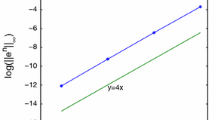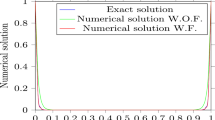Abstract
An initial-boundary value problem for the generalized Schrödinger equation in a semi-infinite strip is solved. A new family of two-level finite-difference schemes with averaging over spatial variables on a finite mesh is constructed, which covers a set of finite-difference schemes built using various methods. For the family, an abstract approximate transparent boundary condition (TBC) is formulated and the solutions are proved to be absolutely stable in two norms with respect to both initial data and free terms. A discrete TBC is derived, and the stability of the family of schemes with this TBC is proved. The implementation of schemes with the discrete TBC is discussed, and numerical results are presented.
Similar content being viewed by others
REFERENCES
J.-F. Berger, M. Girod, and D. Gogny, “Time-Dependent Quantum Collective Dynamics Applied to Nuclear Fission,” Comp. Phys. Commun. 63, 365–374 (1991).
H. Goutte, J.-F. Berger, P. Casoly, and D. Gogny, “Microscopic Approach of Fission Dynamics Applied to Fragment Kinetic Energy and Mass Distribution in 238U,” Phys. Rev. C 71((1–13)), 4316 (2005).
X. Antoine, A. Arnold, C. Besse, et al., “A Review of Transparent and Artificial Boundary Conditions Techniques for Linear and Nonlinear Schrödinger Equations,” Commun. Comput. Phys. 4, 729–796 (2008).
A. Arnold, “Numerically Absorbing Boundary Conditions for Quantum Evolution Equations,” VLSI Design 6, 313–319 (1998).
M. Ehrhardt and A. Arnold, “Discrete Transparent Boundary Conditions for the Schrödinger Equation,” Riv. Mat. Univ. Parma 6, 57–108 (2001).
A. Arnold, M. Ehrhardt, and I. Sofronov, “Discrete Transparent Boundary Conditions for the Schrödinger Equation: Fast Calculations, Approximation and Stability,” Commun. Math. Sci. 1, 501–556 (2003).
B. Ducomet and A. Zlotnik, “On Stability of the Crank-Nicolson Scheme with Approximate Transparent Boundary Conditions for the Schrödinger Equation. Part I,” Commun. Math. Sci. 4, 741–766 (2006).
B. Ducomet and A. Zlotnik, “On Stability of the Crank-Nicolson Scheme with Approximate Transparent Boundary Conditions for the Schrödinger Equation. Part II,” Commun. Math. Sci. 5, 267–298 (2007).
A. A. Zlotnik and B. Ducomet, “Stability of a Symmetric Finite-Difference Scheme with Approximate Transparent Boundary Conditions for the Time-Dependent Schrödinger Equation,” Dokl. Akad. Nauk 413, 96–107 (2007) [Dokl. Math. 75, 260–265 (2007)].
F. Schmidt and D. Yevick, “Discrete Transparent Boundary Conditions for Schrödinger-Type Equations,” J. Comput. Phys. 134, 96–107 (1997).
X. Antoine and C. Besse, “Unconditionally Stable Discretization Schemes of Non-Reflecting Boundary Conditions for the One-Dimensional Schrödinger Equation,” J. Comput. Phys. 188, 157–175 (2003).
H. Han, J. Jin, and X. Wu, “A Finite-Difference Method for the One-Dimensional Time-Dependent Schrödinger-Type Equation on Unbounded Domains,” Comput. Math. Appl. 50, 1345–1362 (2005).
C. A. Moyer, “Numerov Extension of Transparent Boundary Conditions for the Schrödinger Equation Discretized in One Dimension,” Am. J. Phys. 72, 351–358 (2004).
M. Schulte and A. Arnold, “Discrete Transparent Boundary Conditions for the Schrödinger Equation, a Compact Higher Order Scheme,” Kinetic Related Models 1(1), 101–125 (2008).
A. A. Zlotnik and I. A. Zlotnik, “On the Stability of a Family of Finite-Difference Schemes with Approximate Transparent Boundary Conditions for the Schrödinger Equations in a Semi-Infinite Strip,” Vestn. Mosk. Energ. Inst., No. 6, 31–45 (2008).
B. Ducomet, A. Zlotnik, and I. Zlotnik, “On a Family of Finite-Difference Schemes with Discrete Transparent Boundary Conditions for a Generalized Schrödinger Equation,” Kinetic Related Models 2(1), 151–180 (2009).
I. A. Zlotnik, “On the Stability of a Family of Finite-Difference Schemes with Approximate Transparent Boundary Conditions for the Nonstationary Schrödinger Equations in a Semi-Infinite Strip,” Vestn. Mosk. Energ. Inst., No. 6, 127–144 (2009).
A. A. Zlotnik, “Some Finite-Element and Finite-Difference Methods for Solving Mathematical Physics Problems with Nonsmooth Data in N-Dimensional Cube,” Sov. J. Numer. Anal. Math. Model. 6, 421–451 (1991).
I. A. Zlotnik, “Computer Simulation of the Tunnel Effect,” Vestn. Mosk. Energ. Inst., No. 6, 10–28 (2010).
Author information
Authors and Affiliations
Corresponding author
Additional information
Original Russian Text © I.A. Zlotnik, 2011, published in Zhurnal Vychislitel’noi Matematiki i Matematicheskoi Fiziki, 2011, Vol. 51, No. 3, pp. 384–406.
Rights and permissions
About this article
Cite this article
Zlotnik, I.A. Family of finite-difference schemes with approximate transparent boundary conditions for the generalized nonstationary Schrödinger equation in a semi-infinite strip. Comput. Math. and Math. Phys. 51, 355–376 (2011). https://doi.org/10.1134/S0965542511030122
Received:
Published:
Issue Date:
DOI: https://doi.org/10.1134/S0965542511030122




